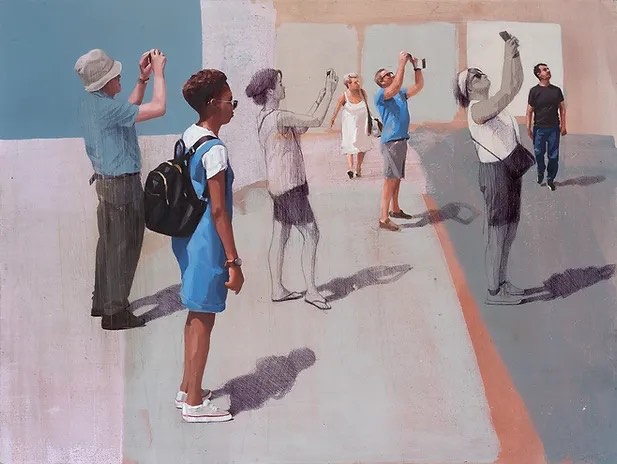Il mondo attuale diviene, per la spiccata sensibilità degli artisti, un affascinante viaggio di esplorazione non solo della realtà oggettivamente evidente bensì anche di tutto l’impercettibile che tende a nascondersi dietro la patina superficiale, inducendo i creativi a effettuare una profonda analisi di tutto ciò che ruota loro intorno e che va a costituire l’essenza, la struttura stessa, dell’esistenzialismo moderno. Un approccio curioso e intimista consente ai creativi che hanno questo atteggiamento nei confronti dell’attualità, e di tutte le implicazioni che essa porta con sé, di soffermarsi su quei dettagli che diversamente sfuggirebbero, facendoli divenire il punto focale della loro produzione per mostrare un significato sottile e impercettibile che è in grado di stimolare anche nell’osservatore le riflessioni più intense. Il protagonista di oggi lavora su diverse serie pittoriche, ma quella che andremo a esplorare si sofferma proprio sulla sua innata capacità di osservare l’uomo nell’ambiente che lo circonda e investigare su tutti i risvolti che gli atteggiamenti più inconsapevoli svelano.
Nel momento in cui la pura ritrattistica, che costituiva la prevalenza della produzione dei secoli predenti all’Ottocento, non riusciva più a soddisfare la necessità di essere al passo con il cambiamento dei tempi, alcuni artisti cominciarono a concentrarsi su una realtà più ampia di quella respirata nei salotti aristocratici percependo l’importanza di andare in strada per immortalare gli ultimi, i lavoratori, gli indigenti, quelli per cui la vita era fatta di stenti e di difficoltà. Il Realismo, sorto intorno alla metà del Diciannovesimo secolo, si propose pertanto di mettere in luce le scene di vita quotidiana, di rendere protagonista la classe più umile che fino a quel momento era stata esclusa dal mondo artistico; le opere di Gustave Courbet e di Jean-François Millet sono importanti testimonianze di questo stile pittorico ma anche importante documento delle condizioni di vita dell’epoca. Con l’avanzare degli anni però la società andò verso profonde modificazioni, la rivoluzione industriale portò i lavoratori verso la consapevolezza dell’importanza del loro ruolo e verso l’esigenza di verdersi riconoscere maggiori diritti, questo non solo nel vecchio continente ma anche nelle Americhe. Ecco dunque che il Realismo divenne un manifesto per tutti quei grandi pittori, da Diego Rivera a Giuseppe Pellizza da Volpedo, che intendevano sostenere la ribellione sociale e il cambiamento epocale che stava avvenendo; ciò che fuoriusciva dalle loro tele dunque era l’idea generale, la forza della moltitudine che andava a reclamare il propri diritti senza soffermarsi sull’individualismo, sul sentire del singolo personaggio perché in quella fase era tutto trascurabile davanti a un obiettivo più alto. Oltrepassato il Novecento e trovando la società equilibri nuovi e diversi, l’arrivo delle due grandi guerre e i successivi periodi di ricostruzione indussero gli artisti ad andare più in profondità, a esplorare le ragioni e le emozioni indivuali dando vita a un Esistenzialismo che si tradusse, dal punto di vista artistico, con movimenti pittorici come l’Espressionismo, il Surrealismo che a sua volta attingeva al sottile senso invisibile e irrazionale di cui erano stati anticipatori gli appartenenti al Simbolismo, in cui l’essere umano e il suo mondo interiore erano centrali. Nell’attualità, dopo le incredibili e rapide modificazioni del modo di vivere, le innovative scoperte tecnologiche, con il benessere costruito durante il dopoguerra e poi perduto poco dopo l’inizio del Ventunesimo secolo, l’atteggiamento esplorativo degli artisti ha spostato il proprio centro di interesse verso una correlazione tra oggettività e soggettività, che è esattamente il fulcro delle opere dell’artista inglese Matt Lambert il quale attraverso uno stile decisamente realista si spinge a esplorare il concetto, il significato che va oltre la pura riproduzione dell’osservato e scava dentro ogni singola espressione dei suoi protagonisti ritratti nella loro spontaneità inconsapevole, quasi gli avesse scattato una fotografia mentale nel momento in cui loro non immaginavano che quello sguardo li avrebbe trasformati in un’opera d’arte.
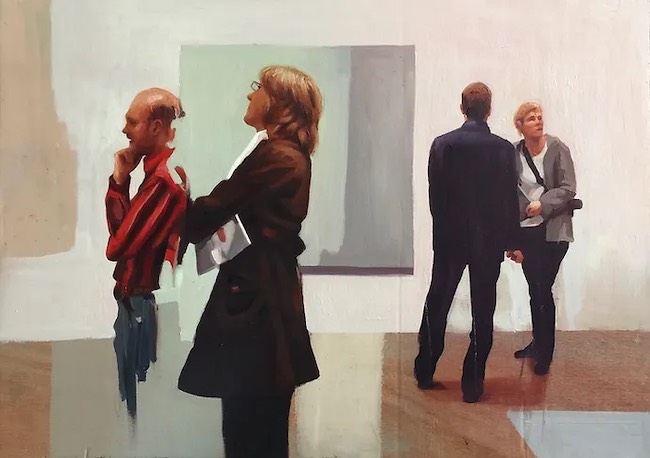
Matt Lambert genera dunque un nuovo Umanesimo in cui mette in evidenza la capacità dell’uomo di comprendere l’importanza della connessione tra individui ma che poi, nel momento in cui si trova un una situazione dove poter socializzare, tende di fatto a chiudersi in se stesso, a fissare lo schermo di un cellulare che non è più un modo per connettersi agli altri bensì un pretesto inconscio di smettere di vivere il momento immortalandolo in vista di un dopo a causa del quale si perde l’adesso.
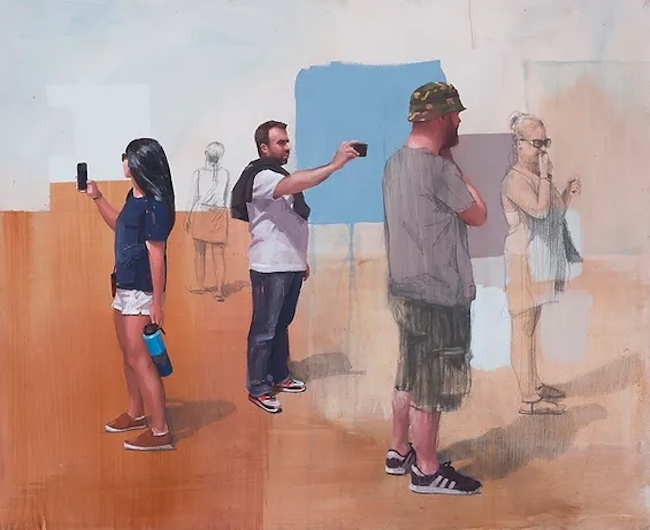
La serie pittorica Observing nasce da un’intuizione avuta dall’artista nel 2007, durante una visita al Moma di New York quando pur avendo un forte interesse per le meravigliose opere esposte non ha potuto fare a meno di guardare le persone intorno a sé, le loro reazioni davanti alla bellezza, l’atteggiamento che ciascuno di loro assumeva davanti all’emozione del dialogo intimo con un’opera d’arte.
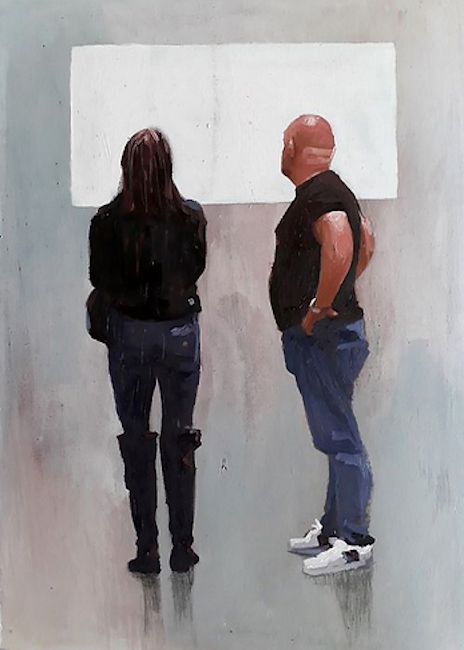
Da quel momento in avanti Matt Lambert ha continuato a voler indagare l’individuo nella sua unicità, nei suoi momenti di aggregazione involontaria che lo inducono ad avere reazioni simili a quella di altri che condividono la sua stessa esperienza, eppure profondamente diverse per le diverse sfaccettature che vanno a comporre il complesso puzzle della personalità di ogni persona; lo sguardo dell’artista non è mai giudicante, al contrario è accogliente e curioso nei confronti di chiunque, va oltre i volti, spesso non visibili, e dà voce al linguaggio del corpo che svela molto di più di quanto sia possibile immaginare.
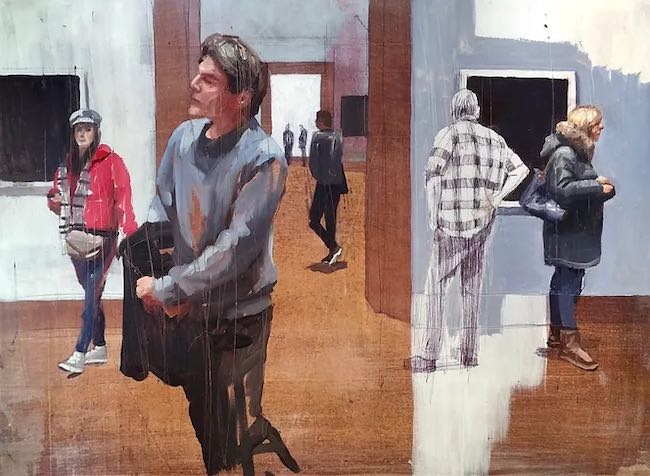
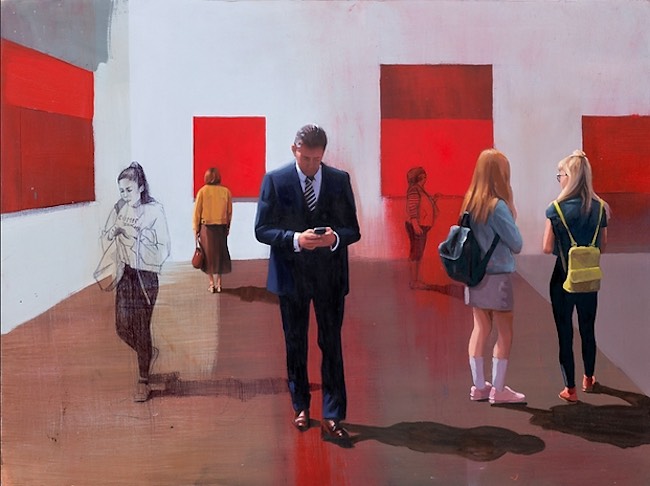
Tuttavia esistono nella società contemporanea abitudini condivise che sono una via di fuga, un modo per distogliere velocemente l’attenzione persino davanti a qualcosa di emozionante; questo è il motivo per cui in molte opere, come in Observing #27, alcuni visitatori sono intenti a guardare il proprio cellulare, come se non potessero fare a meno neanche per un attimo di essere iperconnessi, gestire i propri impegni e i propri affari. L’uomo in abito elegante al centro della scena è distratto da altro al punto di perdersi la bellezza dell’intorno, al punto di dimenticarsi di avere il diritto di dedicare del tempo a se stesso e di cercare un’energia di connessione con le altre persone presenti; la ragazza alla sua sinistra invece sembra essere completamente assente, descritta da Lambert in maniera evanescente, come se fosse indifferente, come se le opere non le avessero trasmesso alcuna emozione.
Questa contrapposizione tra l’uomo che vorrebbe ma non può, narrato dunque con colori pieni e intensi, e la ragazza che può ma non vuole è forte, intenso, induce l’osservatore a riflettere su quante siano state le occasioni in cui si è trovato nell’uno o nell’altro ruolo. È questa la magia delle opere di Matt Lambert, sono inclusive perché fanno sentire il fruitore al centro della scena, gli presentano una realtà conosciuta e osservata distrattamente chissà quante volte e lo costringono a compiere un’analisi dei comportamenti della società in cui vive.
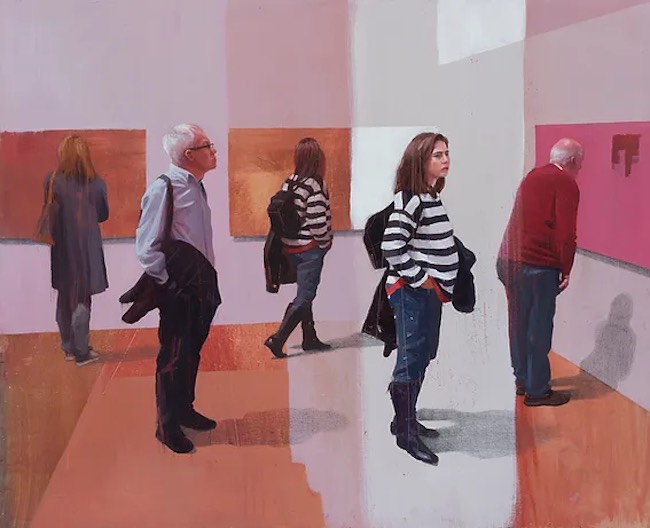
Un’altra caratteristica dell’artista è quella di lasciar cadere righe di colore sulle sue tele, quasi volesse dissolvere alcuni dettagli per andare a cercare l’essenza più profonda, oppure mettere in risalto attraverso il suo tocco pittorico gentile e delicato ciò che è davvero importante, o che ha catturato la sua attenzione, come nel dipinto Observing #39 in cui la donna con la maglia a righe è riprodotta due volte, in lontananza nel primo momento in cui ha colpito nella sala l’attenzione di Lambert, e poi più in vicinanza, come se la sua espressione avesse indotto l’artista a sottolineare il suo atteggiamento apparentemente disinvolto ma di fatto incredibilmente coinvolto sull’opera davanti alla quale si è soffermata. Le colature sono invece riservate alla donna di spalle, come se la sua presenza, seppur fondamentale per la composizione finale, fosse meno rilevante di quella della ragazza con la maglia a righe, malgrado il suo atteggiamento corporeo indichi comunque una forte partecipazione emozionale a ciò che è davanti al suo sguardo.
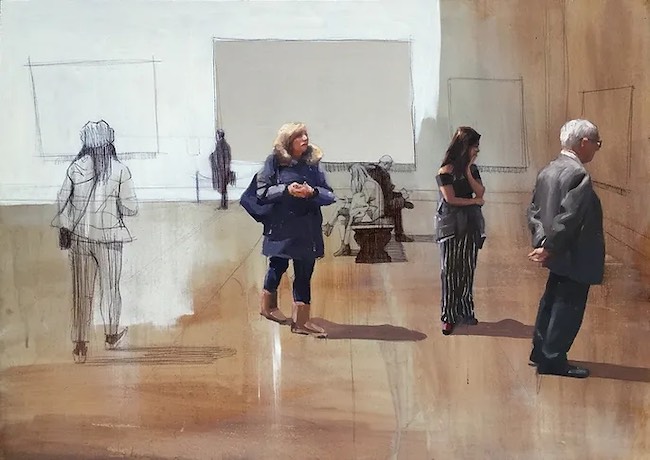
Matt Lambert ha collezionisti in tutto il mondo ed è anche un filantropo; ha fondato l’organizzazione benefica Pass It On Africa (PIOA) insieme al migliore amico James Macdonald, ed è anche uno degli organizzatori dell’annuale Heroes Run di Brighton, una divertente corsa per tutta la famiglia a tema supereroi sul lungomare che si svolge dal 2005.
MATT LAMBERT-CONTATTI
Email: info@mattlambert.co.uk
Sito web: www.mattlambertstudio.co.uk/
Facebook: www.facebook.com/MattLambertStudio/
Instagram: www.instagram.com/mattlambertstudio/
The revelatory observation of the observer in his unawareness, the basis of Matt Lambert’s Expressionist Realism
The current world becomes, for the artists’ keen sensibility, a fascinating journey of exploration not only of the objectively evident reality but also of all the imperceptible that tends to hide behind the superficial veneer, prompting creatives to carry out a profound analysis of everything that revolves around them and that goes to constitute the essence, the very structure, of modern existentialism. An inquisitive and intimate approach allows creatives who have this attitude toward current events, and all the implications it brings with it, to dwell on those details that would otherwise escape, making them become the focal point of their production to show a subtle and imperceptible meaning that is capable of stimulating even the most intense reflections in the observer. Today’s protagonist works on several pictorial series, but the one we are going to explore dwells precisely on his innate ability to observe man in his surroundings and investigate all the implications that the most unconscious attitudes reveal.
At a time when pure portraiture, which constituted the prevalence of production in the centuries preceding the nineteenth century, could no longer meet the need to keep up with the changing times, some artists began to focus on a broader reality than that breathed in aristocratic salons, perceiving the importance of going out into the streets to immortalize the last, the workers, the destitute, those for whom life was made up of hardships and difficulties. Realism, which arose around the middle of the nineteenth century, therefore set out to highlight scenes of everyday life, to make protagonists of the humblest class that had hitherto been excluded from the artistic world; the artworks of Gustave Courbet and Jean-François Millet are important testimonies to this style of painting but also important documents of the living conditions of the time. As the years progressed, however, society moved toward profound changes; the industrial revolution brought workers toward an awareness of the importance of their role and the need to see more rights recognized, this not only in the old continent but also in the Americas.
Here, then, Realism became a manifesto for all those great painters, from Diego Rivera to Giuseppe Pellizza da Volpedo, who intended to support the social rebellion and the epochal change that was taking place; what came out of their canvases therefore was the general idea, the strength of the multitude that went to claim its rights without dwelling on individualism, on the feeling of the single character because at that stage everything was negligible in front of a higher goal. As the twentieth century passed and society found new and different balances, the arrival of the two great wars and the subsequent periods of reconstruction induced artists to go deeper, to explore indivual motives and emotions, giving rise to an Existentialism that translated from the artistic point of view, with pictorial movements such as Expressionism, Surrealism, which in turn drew on the subtle invisible and irrational sense of which those belonging to Symbolism had been the forerunners, in which the human being and his inner world were central. In the present day, after the incredible and rapid changes in the way of life, the innovative technological discoveries, with the prosperity built up during the postwar period and then lost shortly after the beginning of the Twenty-first century, the exploratory attitude of artists has shifted its center of interest toward a correlation between objectivity and subjectivity, which is exactly the focus of the artworks of British artist Matt Lambert who through a decidedly realist style comes out of his way to explore the concept, the meaning that goes beyond the pure reproduction of the observed and digs inside every single expression of his protagonists portrayed in their unconscious spontaneity, as if he had taken a mental photograph of them at the moment when they did not imagine that that gaze would transform them into a work of art. Matt Lambert thus generates a new Humanism in which he highlights man’s ability to understand the importance of connection between individuals but who then, the moment he finds himself in a situation where he can socialize, tends in fact to close in on himself, to stare at the screen of a cell phone that is no longer a way to connect to others but rather an unconscious pretext to stop living the moment by immortalizing it in view of a later time because of which the now is lost. The Observing pictorial series was born from an intuition the artist had in 2007, during a visit to Moma in New York when while having a strong interest in the wonderful works exposed he could not help but look at the people around him, their reactions in front of beauty, the attitude each of them took in front of the emotion of intimate dialogue with an artwork.
From that moment on, Matt Lambert has continued to want to investigate the individual in his uniqueness, in his moments of involuntary aggregation that cause him to have reactions similar to that of others who share his same experience, yet profoundly different because of the different facets that go to make up the complex puzzle of each person’s personality; the artist’s gaze is never judgmental, on the contrary it is welcoming and curious towards anyone, it goes beyond faces, often not visible, and gives voice to body language that reveals much more than it is possible to imagine. However, there are shared habits in contemporary society that are an escape route, a way to quickly divert attention even in the face of something exciting; this is why in many paintings, as in Observing #27, some visitors are intent on looking at their cell phones, as if they cannot help but be hyper-connected for even a moment, managing their busy schedules and affairs. The man in a suit in the center of the scene is distracted by other things to the point of missing the beauty of his surroundings, to the point of forgetting that he has the right to dedicate time to himself and to seek an energy of connection with the other people present; the girl to his left, on the other hand, seems to be completely absent, described by Lambert evanescently, as if she were indifferent, as if the paintings conveyed no emotion to her. This juxtaposition between the man who would like but cannot, narrated therefore in full, intense colors, and the girl who can but does not want to is strong, intense, inducing the viewer to reflect on how many occasions he has been in one or the other role.
This is the magic of Matt Lambert‘s artworks; they are inclusive because they make the viewer feel at the center of the scene, facing him with a reality known and absent-mindedly observed who knows how many times, and force him to make an analysis of the behaviors of the society in which he lives. Another characteristic of the artist is to drop lines of color on his canvases, as if he wanted to dissolve some details to go for the deeper essence, or to highlight through his gentle and delicate pictorial touch what is really important, or what has caught his attention, as in the painting Observing #39 in which the woman in the striped sweater is reproduced twice, in the distance in the first moment when she caught Lambert‘s attention in the room, and then more in proximity, as if her expression caused the artist to emphasize her seemingly casual but in fact incredibly involved attitude on the painting in front of which she lingered. The castings, on the other hand, are reserved for the woman from behind, as if her presence, though crucial to the final composition, was less relevant than that of the girl in the striped shirt, despite the fact that her bodily attitude nonetheless indicates a strong emotional participation in what is before her gaze. Matt Lambert has collectors all over the world and is also a philanthropist; he founded the charity Pass It On Africa (PIOA) with best friend James Macdonald, and is also one of the organizers of Brighton’s annual Heroes Run, a fun, superhero-themed family run along the waterfront that has been held since 2005.


